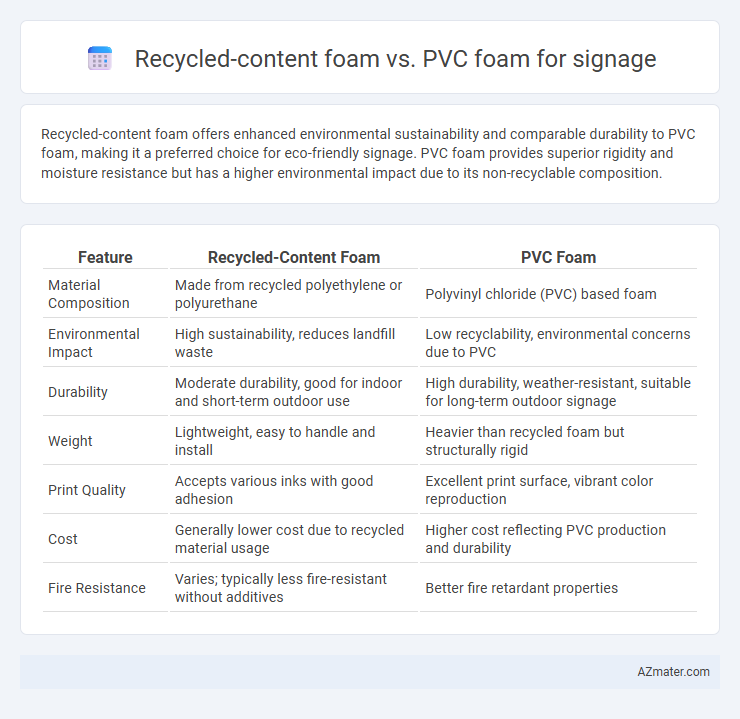Recycled-content foam offers enhanced environmental sustainability and comparable durability to PVC foam, making it a preferred choice for eco-friendly signage. PVC foam provides superior rigidity and moisture resistance but has a higher environmental impact due to its non-recyclable composition.
Table of Comparison
| Feature | Recycled-Content Foam | PVC Foam |
|---|---|---|
| Material Composition | Made from recycled polyethylene or polyurethane | Polyvinyl chloride (PVC) based foam |
| Environmental Impact | High sustainability, reduces landfill waste | Low recyclability, environmental concerns due to PVC |
| Durability | Moderate durability, good for indoor and short-term outdoor use | High durability, weather-resistant, suitable for long-term outdoor signage |
| Weight | Lightweight, easy to handle and install | Heavier than recycled foam but structurally rigid |
| Print Quality | Accepts various inks with good adhesion | Excellent print surface, vibrant color reproduction |
| Cost | Generally lower cost due to recycled material usage | Higher cost reflecting PVC production and durability |
| Fire Resistance | Varies; typically less fire-resistant without additives | Better fire retardant properties |
Introduction to Foam Materials in Signage
Recycled-content foam and PVC foam are popular materials used in signage for their durability and versatility. Recycled-content foam offers environmental benefits by incorporating sustainable materials while maintaining good structural integrity. PVC foam is highly favored for its lightweight, moisture resistance, and ease of customization in various indoor and outdoor signage applications.
What is Recycled-Content Foam?
Recycled-content foam is a sustainable material made by repurposing post-industrial or post-consumer waste into new foam products, reducing environmental impact compared to traditional foams. It offers durability and lightweight properties similar to PVC foam but with a lower carbon footprint and increased eco-friendliness, making it ideal for environmentally conscious signage applications. This foam supports circular economy practices by minimizing landfill waste and conserving natural resources while maintaining high performance in outdoor and indoor signage displays.
Overview of PVC Foam in Signage
PVC foam is widely used in signage due to its durability, lightweight nature, and excellent weather resistance, making it ideal for both indoor and outdoor displays. Its smooth surface allows for high-quality printing and easy finishing, which enhances visual appeal and design versatility. PVC foam's resistance to moisture, chemicals, and UV exposure ensures long-lasting performance in various environmental conditions.
Environmental Impact: Recycled-Content vs. PVC Foam
Recycled-content foam for signage significantly reduces environmental impact by utilizing post-consumer materials and lowering landfill waste compared to virgin PVC foam, which is derived from non-renewable fossil fuels and emits toxic chemicals during production and disposal. The biodegradability and lower carbon footprint of recycled foam improve sustainability, whereas PVC foam's persistence in ecosystems contributes to long-term pollution and challenges in recycling. Choosing recycled-content foam supports circular economy principles and reduces greenhouse gas emissions linked to raw material extraction and manufacturing processes associated with PVC.
Durability and Longevity Comparison
Recycled-content foam offers enhanced environmental benefits while maintaining competitive durability for signage applications, resisting dents, and weathering effectively under moderate conditions. PVC foam provides superior longevity with excellent resistance to moisture, chemicals, and UV exposure, making it ideal for outdoor signage requiring long-term performance. Choosing between recycled-content foam and PVC foam depends on balancing sustainability goals with the need for robust, long-lasting signage materials.
Print Quality and Visual Appeal
Recycled-content foam offers a smooth surface that enhances print quality and provides vibrant color reproduction ideal for high-resolution signage. PVC foam is known for its consistent texture and durability, maintaining sharpness and clarity in printed graphics over time. Both materials support excellent visual appeal, but recycled-content foam delivers an eco-friendly advantage without compromising image sharpness.
Cost Analysis: Recycled-Content Foam vs. PVC Foam
Recycled-content foam offers a cost-effective alternative to PVC foam, typically reducing material expenses by up to 20% due to lower raw material and manufacturing costs. While PVC foam provides durability and weather resistance that may lower long-term maintenance costs, recycled foam's affordability makes it appealing for budget-conscious signage projects. Considering the total cost of ownership, recycled-content foam balances initial investment and environmental benefits against the slightly higher durability premium of PVC foam.
Ease of Fabrication and Installation
Recycled-content foam offers enhanced ease of fabrication due to its consistent density and lightweight nature, allowing precise cutting and shaping with standard tools. PVC foam, while durable, often requires more specialized equipment for clean cuts and can be heavier, complicating installation processes. The lighter weight and smoother finish of recycled-content foam reduce labor time and simplify mounting, making it a preferred choice for efficient signage production.
Sustainability Certifications and Regulatory Compliance
Recycled-content foam used in signage typically meets stringent sustainability certifications such as FSC, GREENGUARD, and EPA guidelines, ensuring low environmental impact and health safety. PVC foam, while durable and cost-effective, often faces scrutiny for containing harmful phthalates and chlorine, resulting in stricter regulatory compliance requirements under REACH and RoHS standards. Choosing recycled-content foam supports circular economy principles and reduces carbon footprint, aligning with green building certifications like LEED and WELL.
Choosing the Best Foam for Your Signage Needs
Recycled-content foam offers eco-friendly benefits and reduces environmental impact while maintaining durability and lightweight properties ideal for signage applications. PVC foam provides excellent rigidity, weather resistance, and a smooth surface suitable for high-quality graphic printing and outdoor displays. Selecting the best foam depends on prioritizing sustainability with recycled materials or opting for PVC's superior durability and print quality for long-lasting signage.

Infographic: Recycled-content foam vs PVC foam for Signage
 azmater.com
azmater.com